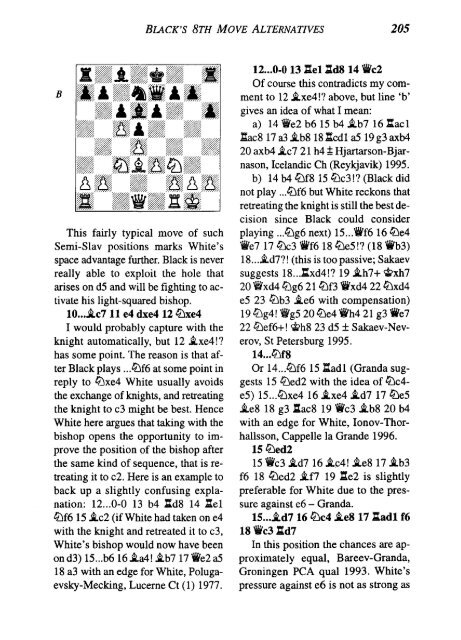Botvinnik Semi-Slav, The (Pedersen)
Create successful ePaper yourself
Turn your PDF publications into a flip-book with our unique Google optimized e-Paper software.
BLACK'S 8TH MOVE ALTERNATIVES 205<br />
B<br />
This fairly typical move of such<br />
<strong>Semi</strong>-<strong>Slav</strong> positions marks White's<br />
space advantage further. Black is never<br />
really able to exploit the hole that<br />
arises on d5 and will be fighting to activate<br />
his light-squared bishop.<br />
10 ... .i.c7 11 e4 dxe4 12lDxe4<br />
I would probably capture with the<br />
knight automatically, but 12 .i.xe4!?<br />
has some point. <strong>The</strong> reason is that after<br />
Black plays ... lDf6 at some point in<br />
reply to lDxe4 White usually avoids<br />
the exchange of knights, and retreating<br />
the knight to c3 might be best. Hence<br />
White here argues that taking with the<br />
bishop opens the opportunity to improve<br />
the position of the bishop after<br />
the same kind of sequence, that is retreating<br />
it to c2. Here is an example to<br />
back up a slightly confusing explanation:<br />
12 ... 0-0 13 b4 .:ld8 14 l:tel<br />
lDf6 15 .i.c2 (if White had taken on e4<br />
with the knight and retreated it to c3,<br />
White's bishop would now have been<br />
on d3) 15 ... b6 16 .i.a4! i.b7 17 'ii'e2 a5<br />
18 a3 with an edge for White, Polugaevsky-Mecking,<br />
Lucerne Ct (I) 1977.<br />
12 ... 0-013 l:tell:td8 14 'iVc2<br />
Of course this contradicts my comment<br />
to 12 .i.xe4!? above, but line 'b'<br />
gives an idea of what I mean:<br />
a) 14 'ii'e2 b6 15 b4 .i.b7 16 .:lac1<br />
l:tac8 17 a3 .i.b8 18l:tcdl a5 19 g3 axb4<br />
20 axb4 i.c7 21 h4 ~ Hjartarson-Bjarnason,<br />
Icelandic Ch (Reykjavik) 1995.<br />
b) 14 b4lDf8 15lDc3!? (Black did<br />
not play ... lDf6 but White reckons that<br />
retreating the knight is still the best decision<br />
since Black could consider<br />
playing ... lDg6 next) 15 ... 'ii'f6 16lDe4<br />
'ii'e7 17lDc3 'ii'f6 18lDe5!? (18 'ii'b3)<br />
18 ... i.d7?! (this is too passive; Sakaev<br />
suggests 18 ... l:txd4!? 19 .i.h7+ ~xh7<br />
20 'ilVxd4lDg6 21lDf3 'ii'xd4 22lDxd4<br />
e5 23 lDb3 .i.e6 with compensation)<br />
19lDg4! 'ii'g5 20lDe4 'ii'h4 21 g3 'fie7<br />
22lDef6+! ~h8 23 d5 ± Sakaev-Neverov,<br />
St Petersburg 1995.<br />
14 ... lDf8<br />
Or 14 ... lDf6 15 :'adl (Granda suggests<br />
15 lDed2 with the idea of lDc4-<br />
e5) 15 ... lDxe4 16 .i.xe4 .i.d7 17 lDe5<br />
i.e8 18 g3 :'ac8 19 'ii'c3 .i.b8 20 b4<br />
with an edge for White, lonov-Thorhallsson,<br />
Cappelle la Grande 1996.<br />
15lDed2<br />
15 'ii'c3 .i.d7 16 .i.c4! i.e8 17 .i.b3<br />
f6 18 lDed2 .i.f7 19 :'e2 is slightly<br />
preferable for White due to the pressure<br />
against e6 - Granda.<br />
15 ... .i.d7 16lDc4 .i.e8 17 .:ladl f6<br />
18 'iVc3 :'d7<br />
In this position the chances are approximately<br />
equal, Bareev-Granda,<br />
Groningen peA qual 1993. White's<br />
pressure against e6 is not as strong as



